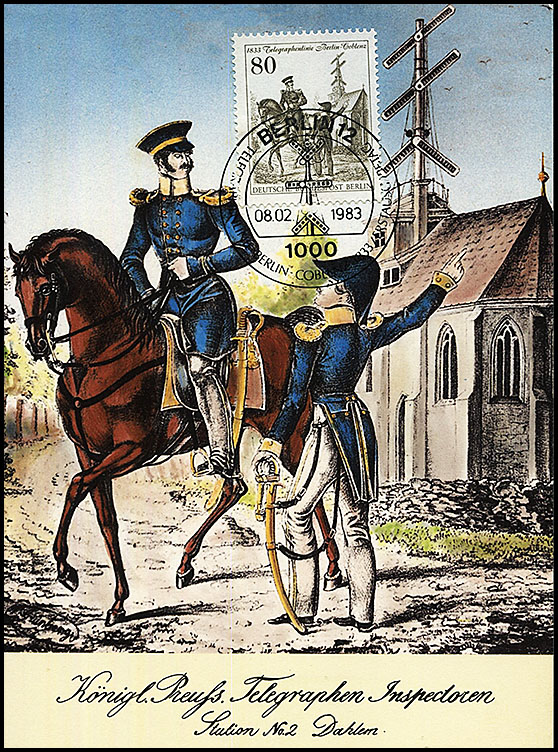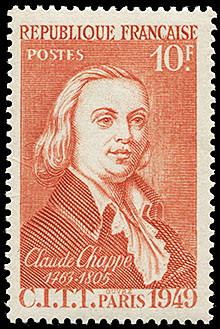- Australia 1901-1988
- New South Wales
- Queensland
- South Australia
- Tasmania
- Victoria
- Western Australia
- International
- Special aspects
In the beginning ... Chappe and his optical telegraph.
The first true telegraph involving the exchange of symbolic codes was developed by Claude Chappe in the late 1700s. Such an approach replacd a physical exchange to convey a message or a semaphore system using flags. |
 |
 |
|
| Chappe's approoach was an optical telegraph as opposed to the electric telegraph which developed soon after. It became used very extensively in France and in a number of other European countries.
The basis of Chappe's system was a long series of towers - each tower being within sight of the next tower. On each tower there was a wooden mast with two crossarms suspended by pivots. A message was passed by spelling out words according to a semaphore code. That process was repeated from one tower to the next. |
Electric telegraphic communication was first developed by Francis Ronalds in 1816. He showed a working connection could be established along an eight mile wire he erected in his mother's garden It is not recorded where his mother was hanging the washing during his experiment. in Hammersmith, U.K. He was happy with his results and proceeded to construct a working telegraph system in and under his Mum's garden. With great insight, the Secretary of the Admiralty rejected Ronalds' ideas as being "wholly unnecessary". Ronalds had even written in his results a scenario which was actually achieved a century later.
Ronalds changed course in his research and developed two drawing instruments which produced perspective in their images. He also founded the Kew ObservatoryThis might have been called the Hammersmith Observatory but Mum had taken her garden back!!!! which became one of the foremost astronomical observatories in the world.
The Cooke and Wheatstone partnership.
The next development resulted from the efforts of two English scientists/inventors - William Fothergill Cooke and Charles Wheatstone. Together they developed what is now referred to as the Cooke-Wheatstone electrical telegraph and patented it in 1837.
- In the early 1830s, Cooke had been introduced to the concept of electrical telegraphy by work conducted by the German Georg Munke and the Baltic German Pavel Schilling. At the time, Coooke was studying medicine which he promptly gave up and successfully attempted to put the invention of electrical telegraphy into practical operation.
- Also in the early 1930s, Wheatstone was researching the velocity of electricity. He developed and improved the concept of balancing two legs of a bridging circuit. His apparatus is now referred to as a Wheatstone Bridge. His experiments related to the velocity at which electricity moves along a wire soon revealed that an electrical current can be retarded especially depending on the properties of the conductor and on the way the wire is encased. He therefore soon revealed that a current moving through a cable buried underground was slower than a current moving through a cable suspended in the air.
By the time Cooke met Wheatstone in early 1837, Cooke had already successfully implemented a system using Schilling's device using three needles to convey a message. Indeed Cooke negotiated with the Liverpool and Manchester Railway to use his system of telegraphs. Very soon after - in May 1837 - Cooke and Wheatstone formed a partnership. In 1838, the Great Western Railway installed a five-needle telegraph between Paddigton Station and West Drayton. This line was the first commercial telegraph in the world.
The system adopted by Cooke and Wheatstone for sending messages was very complex - it required a separate key for each letter of the alphabet. An alternative system of imprinting dots and dashes onto a moving strip of paper to represent letters was so much simpler that it was soon adopted.
Extensions of the telegraph were constructed to other regions the next four years or so. As the Great Western Railway did not want its line to be opened to the public, Cooke financed the extensions. He offered the Great Western free use of the line as long as he could make it available to the public. That move created the first Telegraph Office opened to the public and the mode of transmission created the position of Telegraph Operator.
Wikipedia has an excellent description of the details of these early developments.
Cooke's Electric Telegraph Company.
By 1843, a dispute had developed between the Cooke and Wheatstone but it was apparently quickly settled. Cooke then branched out by himself. In 1846, Cooke founded the Electric Telegraph Company (ETC), together with associates including a financier John Ricado. It was the world's first public telegraph company.
Other links were established by the ETC to:
- Ireland: A cable linked England to Ireland in 1853. It was laid by the Magnetic and so beat the cable laid by the ETC to the task.
- The Channel Islands: A company formed in 1857 as a subsidiary of the ETC and called the Channel Islands Telegraph Company laid a to cable Jersey, Guernsey and Alderney. After many problems with the rocky coast and the hazardous waves caused by the significant tidal movements, the cable was abandoned in 1860. A cable was constructed to the Isle of Man in 1859.
The development of the telegraph system in Britain was therefore in the hands of private enterprise. Unfortunately that responsibility only lated until 1870 when nationalisation of the telegraphs occurred. To that time, 64 private telegraph companies had been established and nearly 70% of them failed. After the Telegraph Act of 1870 was passed, the ETC was the largest part of the State monopoly which then operated under the umbrella of the G.P.O. The Submarine Telegraph Company was excluded from this reorganisation because it operated exclusively with international cables. The two companies noted below were included in the nationalisation.
The beginning of the telegraph system in other countries.
In Europe:
France: the system based on the optical telegraph was entrenched and widespread. Hence the conversion to the electric telegraph was slower in France than elsewhere. A coding system based on - and therefore compatible with - the Chappe coding was introduced.
Germany: William Robinson and his step-son Charles introduced the Morse telegraph in Hamburg's Böresenarkaden Stock Exchange arcade. in July 1847. Subsequently, they sold 2 units each to the Hanoverian State Railroad, the Hamburg-Cuxhaven line, the Bremen-Bremerhaven line and the Kingdom of Prussia for the Berlin-Cologne line. The Robinsons therefore played a pivotal role in establishing Germany's first telegraph lines. The Morse telegraph had not been patented in Europe.
In North America.
Canada: For a summary of the First Telegraph in Canada, see elsewhere.
- 19 December 1846: A 40 mile line in Ontario from Toronto to Hamilton opened. The line was owned by the Toronto-Hamilton-Niagara and St. Catherines Electro-Magnetic Telegraph Company.
- 14 January 1847: A line from Toronto to Buffalo N.Y. was opened.
- 3 August 1847: A line was opened between Toronto and Montreal (Quebec) by the Montreal Telegraph Company.
- In 1868, the Dominion Telegraph Company was established and so provided the first competition in Canada. In 1883, Dominion and the North Western Company merged. Ultimately that amalgamation led to Western Union.
United States:
Samuel Morse constructed his telegraph apparatus in 1837. It used an electro-magnet and a stylus to record signals received over the wire onto a piece of paper.
The actual code which was written in the paper was first developed by Alfred Vail - although it is referred to as Morse code. It used characters and pauses of various lengths. In 1849, Friedrich Gerke, who was the supervisor of the first Morse telegraph line in Hamburg, changed the nature of the code. His revision eliminated characters and used only dots, dashes and pauses. All had the same length. Again a practioner knew what was the most appropriate in the practical, day-too-day setting. Indeed Gerke's code was adopted as the international standard in 1864. An example of an Australian message sent in morse code is included in the Wheatstone section.
Samuel Morse and Alfred Vail sent the first demonstration message over a two mile line at the Speedwell Ironworks in New Jersey on 6 January 1838. This first successful transmission carried the message "A patient waiter is no loser". Soon after, Morse demonstrated his concept to the Franklin Institute and to President Martin van Buren.
On 3 March 1843, the U.S. Congress appropriated funds for Morse to erect a telegraph wire from Washington D.C. to Baltimore. His attempt was to lay the cable underground but the system kept failing. As Cooke and Wheatstone were, at the same time erecting their line on poles in England, Morse changed his strategy.
On 24 May 1844, Morse sent his now famous message "What hath God wrought?" to Washington. At the time, politicians were coincidently devoting their attention to the Presidential nominating conventions in Baltimore. They were very quick (given the circumstances) to recognise the posssibility - and desirability - of almost instantaneous news reporting. For a complete timeline, see elsewhere.